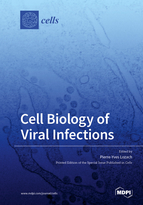Cell Biology of Viral Infections
A special issue of Cells (ISSN 2073-4409). This special issue belongs to the section "Cellular Immunology".
Deadline for manuscript submissions: closed (15 August 2020) | Viewed by 112452
Special Issue Editor
Interests: amyloids; arbovirus; cell biology of virus entry; viral virulence factors
Special Issues, Collections and Topics in MDPI journals
Special Issue Information
Dear Colleagues,
Viruses are rather small infectious agents that replicate and amplify in a wide range of hosts, including pro- and eukaryotes. Many cause severe human diseases—sometimes fatal—and represent a global threat to public health, as exemplified by the recent outbreaks of Ebola virus and the lasting problem created by the human immunodeficiency virus worldwide. Viruses exhibit an important diversity in the degree of severity of the diseases they cause. It undoubtedly reflects the large variety of molecular and cellular processes they subvert, or with which they interfere, in host cells for infectious entry, viral replication, and spread. In this Special Issue of Cells, I would like to include both review papers and research articles that together can not only provide a glance into the latest research in the cell biology of viral infections but also highlight the major achievements in the field of virus–host cell interactions made in recent years. Studies covering all aspects of virus life cycles and interactions between viruses and host cells are welcome, which also include novel technological approaches. With this Special Issue, I aim to offer a space for enthusiastic discussions on future research directions on virus–host cell interactions and promote some areas that are understudied or emerging.
Dr. Pierre-Yves Lozach
Guest Editor
Manuscript Submission Information
Manuscripts should be submitted online at www.mdpi.com by registering and logging in to this website. Once you are registered, click here to go to the submission form. Manuscripts can be submitted until the deadline. All submissions that pass pre-check are peer-reviewed. Accepted papers will be published continuously in the journal (as soon as accepted) and will be listed together on the special issue website. Research articles, review articles as well as short communications are invited. For planned papers, a title and short abstract (about 100 words) can be sent to the Editorial Office for announcement on this website.
Submitted manuscripts should not have been published previously, nor be under consideration for publication elsewhere (except conference proceedings papers). All manuscripts are thoroughly refereed through a single-blind peer-review process. A guide for authors and other relevant information for submission of manuscripts is available on the Instructions for Authors page. Cells is an international peer-reviewed open access semimonthly journal published by MDPI.
Please visit the Instructions for Authors page before submitting a manuscript. The Article Processing Charge (APC) for publication in this open access journal is 2700 CHF (Swiss Francs). Submitted papers should be well formatted and use good English. Authors may use MDPI's English editing service prior to publication or during author revisions.
Keywords
- cell death
- cellular receptor
- degradative pathways
- innate immune response
- intracellular trafficking
- DNA/RNA organization and synthesis
- membrane fusion
- signaling pathways
- virus
- virus–host cell interactions







